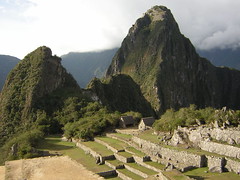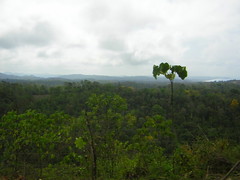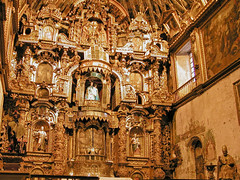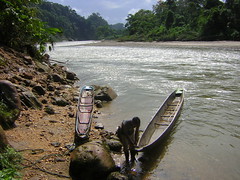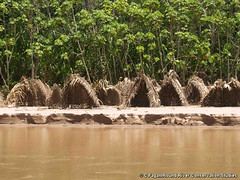Naylamp’s temple discovered in Lambayeque
After eight months of careful excavation, archaeologists of the Brüning Museum in Lambayeque have discovered, next to the Huaca Chornancap pyramid, what is thought to be the sacred temple of Naylamp, a supposedly mythical ruler that according to oral legend was the founder of the post-Moche Lambayeque civilisation.
Adapted from an article by Wilfredo Sandoval for El Comercio

By Carlos Wester La Torre
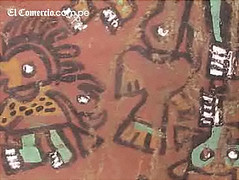
Wall paintings
The multicoloured scenes of human sacrifice in which we see armed warriors carrying decapitated heads – partially revealed in 1983 by investigator Christopher Donnan – were the clues archaeologists followed during eight months of the excavation and discovery of a sacred building.
More than a thousand years old, it is thought to be the temple of Naylamp, the supposedly mythical founder of the post-Moche civilisations in the region.
Removing the sand dunes that for centuries covered the 250 square metres that make up the temple took as many as 50 men, directed by archaeologist Carlos Wester La Torre, using only small digging tools and wheelbarrows to haul away the carefully removed sands, all in the midst of strong winds that plague the area.

More paintings
As soon as the excavations began, researchers could immediately appreciate the structure of the temple.
A series of paintings – with representations of the ceremonies that where realised in the temple, as well as shapes and patterns immediately recognizable as Mochica and Lambayeque iconography – covered a number of walls on the highest parts of the adobe structure.
The Enigmatic Throne
The appearance of algarrobo tree trunks that formed part of the roof of the temple filled the researches with expectation. Metres below they found a throne in a perfect state of conservation, located closest to the Chornancap pyramid. This would have been used by whoever was the political, religious or military power of the time.
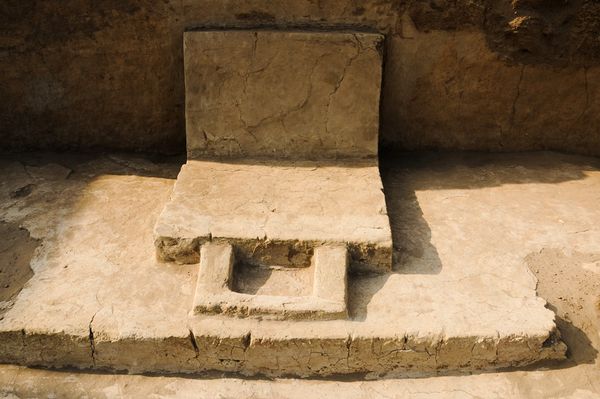
Throne – by Carlos Wester La Torre
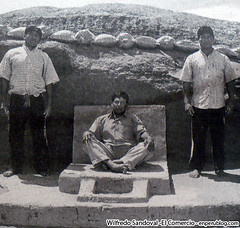
The throne
The researchers think that the temple has a direct relationship with Naylamp, a mysterious figure who, according to legend, arrived in the decades following the collapse of the Moche on a fleet of vessels.
This strange ruler covered in the feathers of birds from a distant tropical land rebuilt civilisation in the region, giving birth to the Chimú and the Sicán societies, before passing on his kingdoms to his sons and himself passing into mythology.
A legend confirmed?
According the the director Brüning Museum, Carlos Wester La Torre, the structure possesses a high level of religious content related to whoever was in power.

A similar structure
“The existence of pedestals in the shape of chakanas (Andean Crosses) and painted murals en which we can appreciate sacred rituals, as well as the well-known anthropomorphic waves, are proof that this site was used by important people, perhaps the founder of the Lambayeque civilisation, Naylamp and his eldest son Cium and other descendants”, he explains.
The discovery of paintings on the walls the surround the temple reinforce the oral tradition of Naylamp, and repeat scenes that appear regularly in the civilisation’s iconography.
The work to uncover the temple cost S/. 700,000 or roughly a quarter of a million US dollars, providing many jobs for locals in the region.
The temple is located next to the Chornacap pyramid, part of the 95-hectare Chotuna-Chornancap archaeological area, which itself is located in one of the ancient world’s most important but relatively unheard-of centres of civilisation, one that features countless hundreds of towering pyramids, thousands of temples, and the ancient world’s longest artificial water channels.
Machu Picchu 2010 Calendar
Deep in the cloud forests of the majestic Andes mountain range are found the remains of an ancient civilisation. Shrouded in the clouds that envelop the sharp peaks, this mystical city is perched perilously high above the Urubamba river after having passed through the Inca’s Sacred Valley.
Explore this magical city of the Incas with 12 months of beautiful photos.
Tags: bruning, chimu, lambayeque, moche, mythology, naymlap, pyramids, ruins, sican



